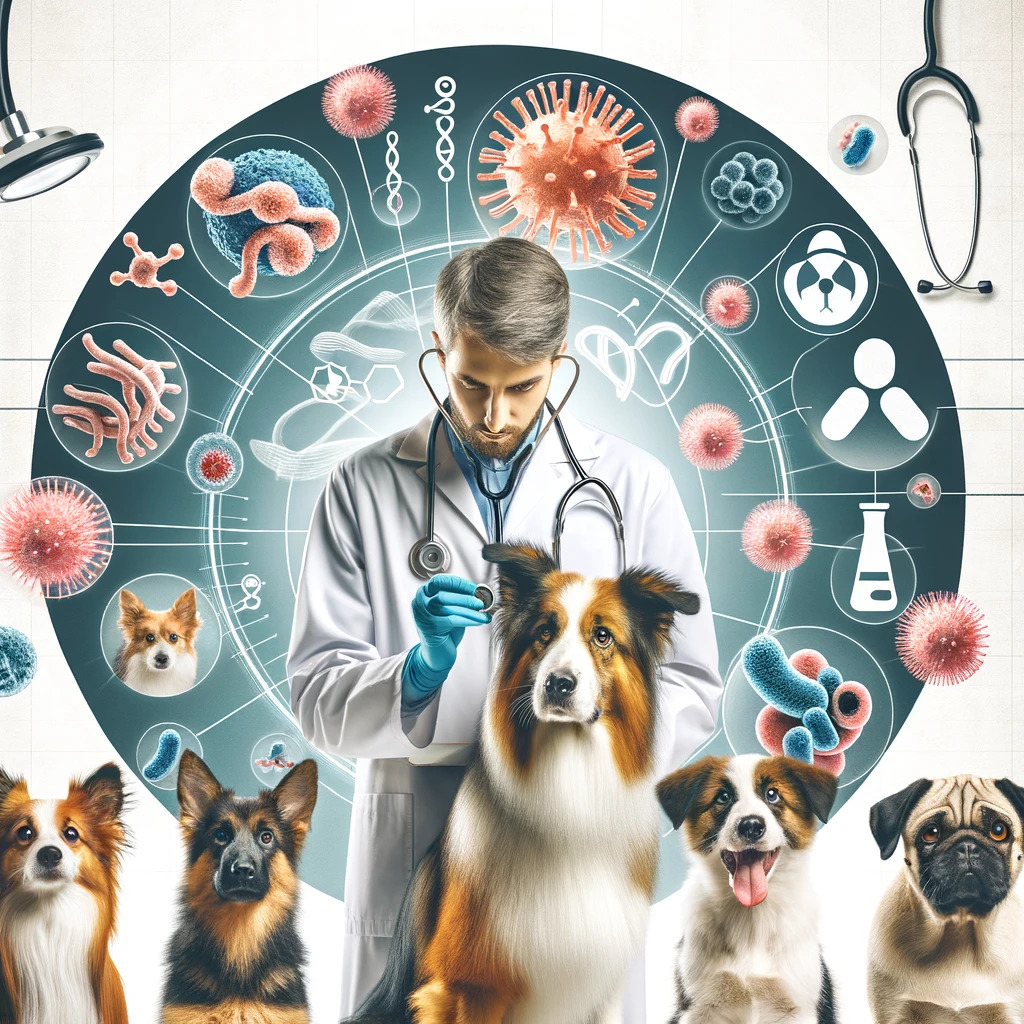Clostridium in dogs is a topic that often raises questions and concerns among pet owners. This comprehensive guide aims to address the most frequently asked questions, providing in-depth information in a structured and easy-to-understand format. Each section focuses on a specific question, offering detailed insights and practical advice.
What is Clostridium in Dogs and How Does it Affect Them?
Clostridium is a type of bacteria that can be found in the environment, particularly in soil, and sometimes in the intestines of animals and humans. While some Clostridium species are harmless, others can cause serious health issues in dogs. The impact of Clostridium on dogs can vary depending on the specific strain of the bacteria and the overall health of the dog.
- Understanding Clostridium: Clostridium consists of various strains, some of which are pathogenic. The most common types affecting dogs include Clostridium perfringens and Clostridium difficile.
- Symptoms and Diagnosis: Dogs affected by Clostridium may exhibit symptoms such as diarrhea, vomiting, abdominal pain, and loss of appetite. Diagnosis typically involves stool analysis and specific tests to identify the bacteria.
- Transmission and Risks: These bacteria can be transmitted through contaminated food, water, or contact with infected feces. Dogs with compromised immune systems or those undergoing antibiotic treatment are at higher risk.
- Treatment Options: Treatment generally includes appropriate antibiotics and supportive care. It’s crucial to follow the vet’s instructions to prevent antibiotic resistance.
- Preventive Measures: Good hygiene practices, regular veterinary checkups, and proper diet can help in preventing Clostridium infections.
- Role of Probiotics: Probiotics may aid in maintaining gut health and preventing bacterial overgrowth.
- Understanding Antibiotic Resistance: Overuse or incorrect use of antibiotics can lead to resistance, making future infections harder to treat.
- Impact on Different Dog Breeds: While all dogs can be affected, some breeds with specific genetic predispositions may be more susceptible.
- Long-Term Effects and Management: Chronic infections may require long-term management strategies and dietary adjustments.
- Role of Veterinary Care: Regular veterinary consultations are essential for early detection and effective management of Clostridium infections.
How is Clostridium Diagnosed in Dogs?
Diagnosing Clostridium in dogs involves a combination of clinical assessment and laboratory tests. Understanding the diagnostic process helps pet owners in recognizing the importance of timely veterinary intervention.
- Clinical Examination: The vet begins with a thorough physical examination, considering the dog’s symptoms, medical history, and any possible exposure to contaminated sources.
- Stool Analysis: A fecal sample is critical for identifying the presence of Clostridium bacteria. Specific tests can differentiate between various Clostridium strains.
- Blood Tests: Blood tests can assess the overall health of the dog and rule out other conditions that might cause similar symptoms.
- Imaging Tests: In some cases, X-rays or ultrasound may be used to assess the extent of intestinal involvement.
- Sensitivity Testing: This test determines which antibiotics are most effective against the specific strain of bacteria.
- Importance of Accurate Diagnosis: Accurate diagnosis is crucial for effective treatment. Misdiagnosis can lead to inappropriate treatment, worsening the dog’s condition.
- Differential Diagnosis: The vet will consider other diseases that cause similar symptoms, like parasites, viral infections, or dietary indiscretion.
- The Role of the Dog Owner: Owners play a vital role in diagnosis by providing detailed information about their dog’s health and behavior.
- Follow-Up Tests: After treatment, follow-up tests may be necessary to ensure the infection is fully resolved.
- Challenges in Diagnosis: Sometimes, diagnosing Clostridium can be challenging due to its symptoms overlapping with other gastrointestinal disorders.
What are the Treatment Options for Clostridium in Dogs?
Treating Clostridium in dogs involves a multi-faceted approach that includes medication, dietary management, and sometimes hospitalization for more severe cases. Understanding these options can help owners make informed decisions about their pet’s care.
- Antibiotics: The primary treatment for Clostridium infections involves antibiotics that target the specific strain of bacteria. The vet will choose the antibiotic based on sensitivity testing.
- Probiotics and Gut Health: Along with antibiotics, veterinarians often recommend probiotics to restore healthy gut flora and support the digestive system.
- Dietary Management: A bland diet, often consisting of boiled chicken and rice, can help soothe the digestive system during recovery.
- Fluid Therapy: In cases of severe diarrhea and vomiting, dogs may need fluid therapy to prevent dehydration.
- Monitoring and Adjustments: Treatment effectiveness should be monitored, and adjustments may be needed based on the dog’s response.
- Preventing Recurrence: Long-term dietary adjustments and regular health checks can help prevent future infections.
- Understanding Medication Side Effects: Owners should be aware of potential side effects of medications and report any concerns to the vet.
- Home Care Tips: Instructions on home care, including diet and medication administration, are crucial for recovery.
- Emergency Situations: In severe cases, hospitalization may be required for intensive care and monitoring.
- Holistic and Supportive Therapies: Some vets may also suggest supportive therapies like acupuncture or herbal remedies as part of the treatment plan.
Can Clostridium in Dogs be Prevented?
Preventing Clostridium infections in dogs is not always possible, but there are several measures that can reduce the risk. Understanding these preventive strategies is crucial for dog owners.
- Hygiene and Sanitation: Regular cleaning of feeding bowls, sleeping areas, and play spaces helps minimize the risk of infection.
- Safe Diet Practices: Avoiding spoiled food and garbage, and ensuring a balanced diet, supports a healthy digestive system.
- Regular Veterinary Checkups: Routine health checks can help in early detection and prevention of various infections, including Clostridium.
- Vaccination and Health Management: While there’s no specific vaccine for Clostridium, keeping up with general vaccinations and health management is beneficial.
- Probiotics and Gut Health: Including probiotics in the dog’s diet may help in maintaining a balanced gut flora.
- Education on Clostridium: Understanding the symptoms and risks associated with Clostridium helps in early recognition and prompt treatment.
- Managing Stress: Reducing stress in dogs, which can impact their immune system, is an important preventive measure.
- Avoiding Antibiotic Overuse: Responsible use of antibiotics, as prescribed by a vet, can prevent antibiotic-resistant strains of bacteria.
- Environmental Awareness: Being cautious about the dog’s environment, especially in areas with high contamination risk, is key.
- Community Health: Responsible pet ownership, including picking up after your dog, contributes to a healthier environment for all pets.
What Are the Long-term Effects of Clostridium on a Dog’s Health?
Understanding the long-term effects of Clostridium infections in dogs is crucial for owners to manage their pet’s health effectively over time.
- Chronic Gastrointestinal Issues: Repeated or severe infections can lead to chronic gastrointestinal problems like inflammatory bowel disease.
- Impact on Overall Health: Long-term health can be compromised, including nutrient absorption issues and weight loss.
- Immune System Effects: Frequent infections can weaken a dog’s immune system, making them more susceptible to other diseases.
- Behavioral Changes: Chronic illness can affect a dog’s behavior, leading to increased irritability or lethargy.
- Dietary Adjustments: Dogs recovering from Clostridium may require lifelong dietary adjustments to maintain gut health.
- Monitoring and Management: Regular veterinary check-ups are essential to monitor any long-term effects and manage ongoing health concerns.
- Quality of Life Considerations: Managing the long-term effects is key to maintaining the dog’s quality of life.
- Role of Owner in Management: Owners play a vital role in managing their dog’s health through attentive care and adherence to veterinary advice.
- Potential for Recurrence: There is a risk of recurrence, and owners should be vigilant for signs of re-infection.
- Education and Awareness: Continuous education about canine health helps owners in making informed decisions for their pet’s well-being.
How Can Clostridium Affect Different Dog Breeds Differently?
The impact of Clostridium on different dog breeds can vary, and understanding these breed-specific susceptibilities is important for tailored care and prevention.
- Breed-Specific Susceptibilities: Some breeds may have genetic predispositions making them more susceptible to Clostridium infections.
- Small vs. Large Breeds: Small breeds might be more prone to certain health issues that can exacerbate the effects of Clostridium, while large breeds may have different challenges.
- Age and Health Factors: Breed-specific age and health factors can influence the severity and management of Clostridium infections.
- Dietary Considerations: Different breeds may require specific dietary considerations that can influence their susceptibility to gastrointestinal issues.
- Immune System Variances: The strength and responsiveness of the immune system can vary among breeds, affecting their ability to fight off infections.
- Symptom Presentation: Symptoms of Clostridium might present differently in different breeds, affecting diagnosis and treatment approaches.
- Management Strategies: Breeds with specific health predispositions may require tailored management strategies to prevent and treat Clostridium infections.
- Veterinary Guidance: Consultation with a vet who understands breed-specific health concerns is crucial for appropriate care.
- Awareness and Education: Owners should educate themselves about their specific breed’s health risks and needs.
- Collaboration in Care: A collaborative approach involving the vet, breeder, and owner is key to managing breed-specific risks related to Clostridium.
What Role Do Diet and Nutrition Play in Managing Clostridium in Dogs?
Diet and nutrition are critical in managing and preventing Clostridium in dogs. A well-balanced diet can strengthen a dog’s immune system and improve gut health.
- Importance of a Balanced Diet: A nutritious, well-balanced diet is essential for maintaining a healthy gut flora, which can help in preventing Clostridium overgrowth.
- Specific Dietary Requirements: Some dogs may require a special diet to manage or prevent Clostridium, especially those with sensitive stomachs or allergies.
- Role of Fiber: A diet with the right amount of fiber can promote healthy bowel movements and support gut health.
- Probiotics and Prebiotics: Incorporating probiotics and prebiotics can help maintain a balanced gut microbiome, which is crucial for preventing bacterial imbalances like Clostridium.
- Avoiding Trigger Foods: Identifying and avoiding foods that trigger gastrointestinal upset in dogs is key in managing Clostridium.
- Hydration: Ensuring your dog is well-hydrated is important, especially if they have suffered from diarrhea or vomiting.
- Regular Feeding Schedule: Consistent feeding times and portion control can help maintain digestive regularity.
- Consulting a Veterinary Nutritionist: In complex cases, consulting a veterinary nutritionist can help in formulating a diet plan tailored to the dog’s specific needs.
- Monitoring and Adjustment: Regularly monitoring a dog’s response to dietary changes is important for ongoing management of gut health.
- Education on Dog Nutrition: Educating yourself on canine nutrition helps in making informed decisions about your dog’s diet.
Are Certain Dog Ages More Susceptible to Clostridium?
Age can be a significant factor in a dog’s susceptibility to Clostridium. Understanding the age-related risks can help owners in providing age-appropriate care.
- Puppies and Clostridium: Puppies, with their developing immune systems, are often more susceptible to infections, including Clostridium.
- Senior Dogs: Older dogs may have weakened immune systems and other health issues that increase their risk of Clostridium infections.
- Age-Related Dietary Needs: Different life stages require different dietary approaches, which can influence gut health and susceptibility to Clostridium.
- Vaccinations and Age: Keeping up with vaccinations is crucial, especially for puppies and senior dogs.
- Preventive Health Care at Different Ages: Regular vet check-ups tailored to the dog’s age can help in early detection and prevention of Clostridium.
- Managing Chronic Conditions: Older dogs may have chronic conditions that need to be managed alongside Clostridium.
- Symptom Recognition in Different Ages: Awareness of how symptoms may present differently in puppies, adult dogs, and seniors is important for timely intervention.
- Special Care for Puppies and Seniors: Puppies and senior dogs may require more intensive care and monitoring if infected with Clostridium.
- Stress Management: Minimizing stress, which can affect immune response, is particularly important for very young and old dogs.
- Owner Education and Awareness: Understanding the specific needs of dogs at different life stages helps in providing the best possible care.
How Does Clostridium Differ from Other Gastrointestinal Infections in Dogs?
Understanding the differences between Clostridium and other gastrointestinal infections is key to accurate diagnosis and effective treatment.
- Symptom Similarities and Differences: While many gastrointestinal infections share common symptoms like diarrhea and vomiting, certain signs may be more specific to Clostridium.
- Causes and Sources: Differentiating the sources of infection, such as contaminated food or water, is important for understanding and treating the condition.
- Diagnostic Tests: Specific diagnostic tests can help distinguish Clostridium from other gastrointestinal issues.
- Treatment Approaches: Treatment for Clostridium may differ from that of other infections, especially in terms of antibiotic choice and dietary management.
- Response to Treatment: The way a dog responds to treatment can also indicate the nature of the infection.
- Prevention Strategies: Preventive measures might vary depending on the type of gastrointestinal infection.
- Impact on Overall Health: The long-term effects on a dog’s health can differ between Clostridium and other gastrointestinal disorders.
- Role of Immune System: The dog’s immune system response to different pathogens is a critical factor in the management of gastrointestinal infections.
- Importance of Veterinary Expertise: Veterinary expertise is essential in correctly diagnosing and treating different types of gastrointestinal infections.
- Educating Dog Owners: Informing dog owners about the differences among various gastrointestinal infections is key to effective prevention and management.
Summary Table
| Topic | Key Points |
| Understanding Clostridium | Clostridium types, symptoms, diagnosis, and risks. |
| Diagnosis of Clostridium | Clinical exam, stool analysis, blood tests, imaging, and sensitivity testing. |
| Treatment Options | Antibiotics, probiotics, dietary management, fluid therapy, and monitoring. |
| Prevention of Clostridium | Hygiene, safe diet, regular vet checks, stress management, and responsible antibiotic use. |
| Long-term Effects | Chronic GI issues, immune system effects, behavioral changes, and quality of life considerations. |
| Impact on Different Breeds | Breed-specific susceptibilities and management strategies. |
| Role of Diet and Nutrition | Balanced diet, fiber, probiotics, hydration, and regular feeding schedule. |
| Age-Related Susceptibility | Puppies and seniors more at risk, age-appropriate care and vaccinations. |
| Clostridium vs. Other GI Infections | Differences in symptoms, causes, treatment, and impact on health. |
| General Clostridium Overview | Comprehensive understanding of Clostridium in dogs. |
Frequently Asked Questions
The most common symptoms include diarrhea, vomiting, abdominal pain, and loss of appetite.
With appropriate treatment, most dogs recover completely, but some might require long-term management.
Some strains can be contagious. It’s important to maintain good hygiene to minimize the risk of transmission.
Recovery time varies depending on the severity of the infection and the dog’s overall health, but typically it ranges from a few days to a couple of weeks.
Some breeds with specific genetic predispositions may be more susceptible to Clostridium infections.
A bland diet, rich in fiber, with probiotics, and proper hydration are generally recommended.
Currently, there is no specific vaccine for Clostridium, but maintaining overall health through regular vaccinations is beneficial.
Conclusion
This comprehensive guide on Clostridium in dogs has covered everything from symptoms and treatment to prevention and breed-specific considerations. Armed with this knowledge, dog owners can better navigate the challenges posed by this condition and ensure the health and happiness of their furry companions. Remember, prompt veterinary care and informed management are key to successfully handling Clostridium infections in dogs.



